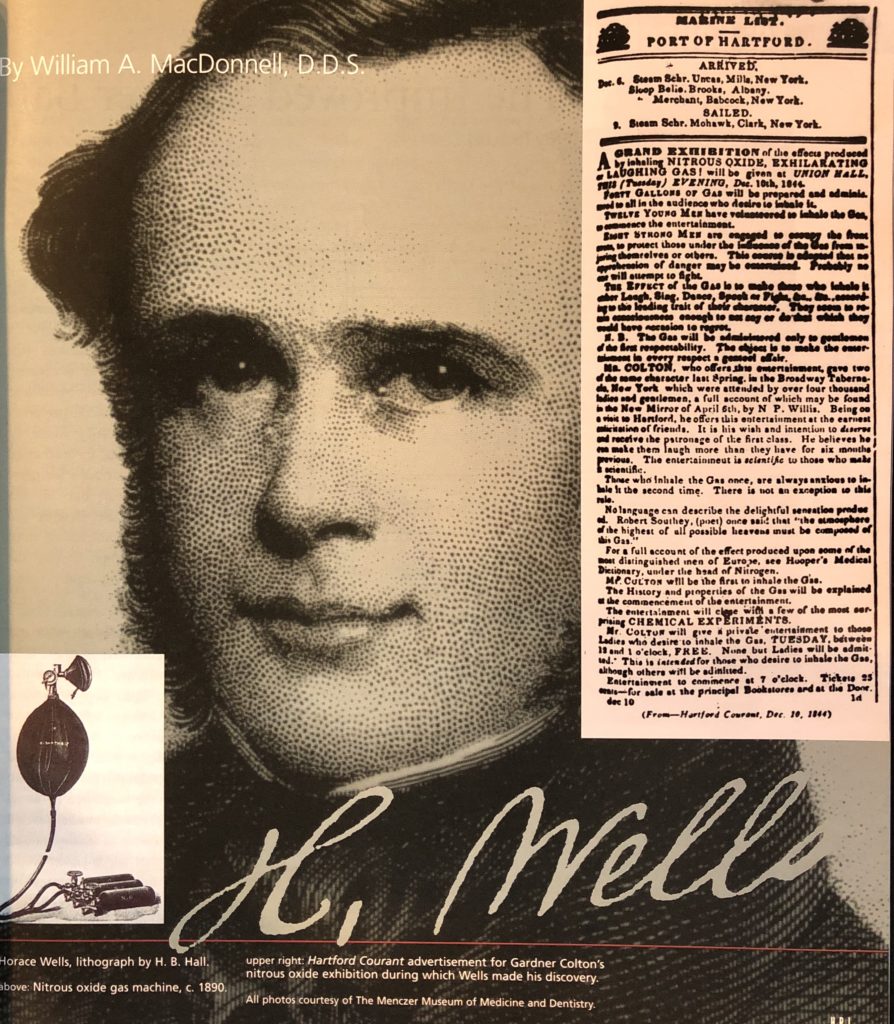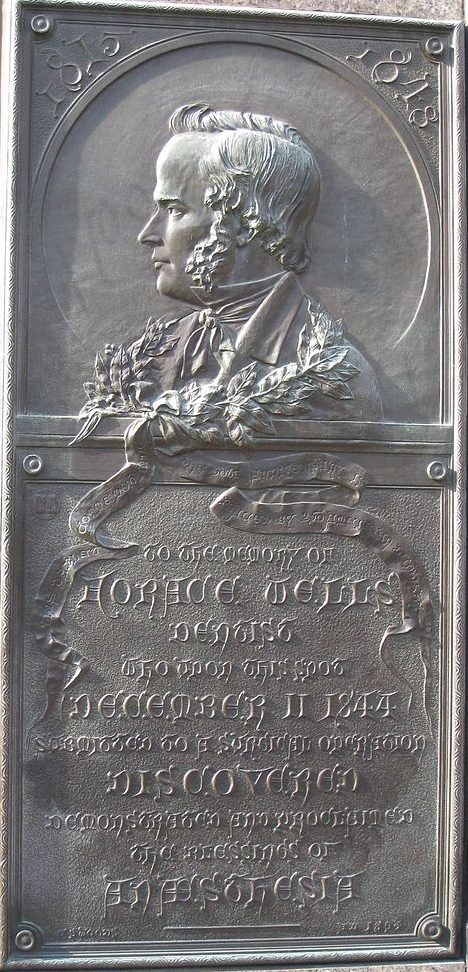
Horace Wells, lithograph by H. B. Hall. bottom left: Nitrous oxide gas machine, c. 1890. upper right: Hartford Courant advertisement for Gardner Colton’s nitrous oxide exhibition during which Wells made his discovery. All photos courtesy of the Menczer Museum of Medicine and Dentistry.
By William A. MacDonnell, D.D.S.
(c) Connecticut Explored Inc. Spring 2005
Subscribe/Buy the Issue!
It was on December 10, 1844 at “A Grand Exhibition of the Effects of Nitrous Oxide, Exhilarating or Laughing Gas” held in Hartford’s Union Hall that Horace Wells (1815-1848), a local dentist, made the connection that changed the painful experience of surgery forever. Demonstrations of nitrous oxide and ether for entertainment were common in those days. Volunteers would inhale nitrous oxide and do funny things for the pleasure of the audience. Samuel Colt had given nitrous oxide shows in the 1830s. At that 1844 “Grand Exhibition” Wells observed that nitrous oxide could be used to eliminate pain and therefore might be used as an anesthetic for medical purposes.
That night, Wells saw Sam Cooley accidentally cut his leg on a bench while under the influence of laughing gas: Cooley showed no sign of pain. Wells asked Cooley if he was aware that be had been injured, and Cooley acknowledged having no pain. As Wells left Union Hall he asked Gardner Q. Colton, the organizer of the event, “Why cannot a man have a tooth extracted and not feel it under the effects of the gas?” That evening Wells conferred with his dental colleague and former student Dr. John Riggs (who years later was Mark Twain’s dentist) about the possibilities of nitrous oxide being used to perform painless surgery.
The next day, December 11, 1844, Wells volunteered to have his wisdom tooth extracted by Dr. Riggs. The surgery was performed under nitrous oxide anesthesia, administered by Colton, in Wells’s dental office on Main Street across from the Old State House. Immediately upon recovering from the dose of nitrous oxide, Wells swung his hands in the air and exclaimed, “A new era in tooth pulling.” Riggs later said, “He [Wells] remarked that he did not feel any pain from the operation.”
For the next several weeks Wells provided anesthesia for extractions as well as operations conducted by two young Hartford physicians. On January 20, 1845, William T. G. Morton (the discoverer of ether anesthesia in 1846 and one-time dental partner of Wells), arranged for a lecture and demonstration by Wells in Boston at Massachusetts General Hospital. However, the patient, a medical student, cried out during the extraction of his tooth, and because of that those present deemed the demonstration a failure. The student afterwards stated that he felt no pain during the procedure. Undaunted, Wells returned to Hartford to provide anesthesia and teach other dentists how to use nitrous oxide.
Wells was born in Hartford, Vermont and studied dentistry in Boston at the age of 19. He moved to Hartford, Connecticut in 1836 where he developed a very successful dental practice. At age 23 he authored a text entitled “An Essay on Teeth” (1838) in which he advocated regular brushing of teeth. Wells held three U.S. patents, a shower bath [see next article], coal sifter, and dental solder, but when friends recommended that he patent his great discovery of anesthesia his response was: “No, let it be as free as the air we breathe.” His former student, Morton, tried to patent “letheon (ether) anesthesia” following a successful demonstration at Massachusetts General Hospital in 1846. Morton later offered Wells the ether “franchise” for New York City. Wells declined the offer.
 The Connecticut legislature passed a bill in 1847 declaring Wells the discoverer of anesthesia, and in 1848 the Parisian Medical Society declared “to Horace Wells of Hartford, USA is due all honors having first discovered and successfully applied the uses of vapors or gases, whereby surgical operations could be performed without pain.” Neither of these honors could assuage Wells’s deep depression, which led to his suicide in January 1848. In fact news of the Parisian Medical Society’s declaration wasn’t delivered until after Wells’s death. His discovery has been recognized by both the American Dental Association (1864) and the American Medical Association (1870 & 1944). According to the world-renowned physician, Sir William Osler, Wells’s discovery of anesthesia constituted “the greatest single gift ever made to suffering humanity.”
The Connecticut legislature passed a bill in 1847 declaring Wells the discoverer of anesthesia, and in 1848 the Parisian Medical Society declared “to Horace Wells of Hartford, USA is due all honors having first discovered and successfully applied the uses of vapors or gases, whereby surgical operations could be performed without pain.” Neither of these honors could assuage Wells’s deep depression, which led to his suicide in January 1848. In fact news of the Parisian Medical Society’s declaration wasn’t delivered until after Wells’s death. His discovery has been recognized by both the American Dental Association (1864) and the American Medical Association (1870 & 1944). According to the world-renowned physician, Sir William Osler, Wells’s discovery of anesthesia constituted “the greatest single gift ever made to suffering humanity.”
The very first statue erected in Bushnell Park, in 1875, was that of Hartford’s greatest humanitarian, Horace Wells. In 2000 The Bushnell Park Foundation and the Hartford Dental Society had the bronze statue restored. Wells’s granite and bronze memorial in Cedar Hill Cemetery was restored in 2004. The bronze plaque commemorating the location of the first application of anesthesia, across the street from the Old State House, was also restored in 2004 in honor of the 160th anniversary of the discovery of anesthesia. Several of Wells’s artifacts, such as his death mask and day book, are on display at the Hartford Medical Society’s Menczer Museum of Medicine and Dentistry, 230 Scarborough Street, Hartford, Connecticut. For more information, call (860) 236-5613.
Dr. William A. MacDonnell is a dentist anesthesiologist and an assistant clinical professor at the University of Connecticut School of Dental Medicine. He served as chair of the Horace Wells Memorial Restoration Committee of the Hartford Dental Society.
Explore!
“Horace Wells, Inventor of an Improved Shower Bath,” Spring 2005
Read more stories about products made and invented in Connecticut and about other Notable Connecticans on our TOPICS pages.
